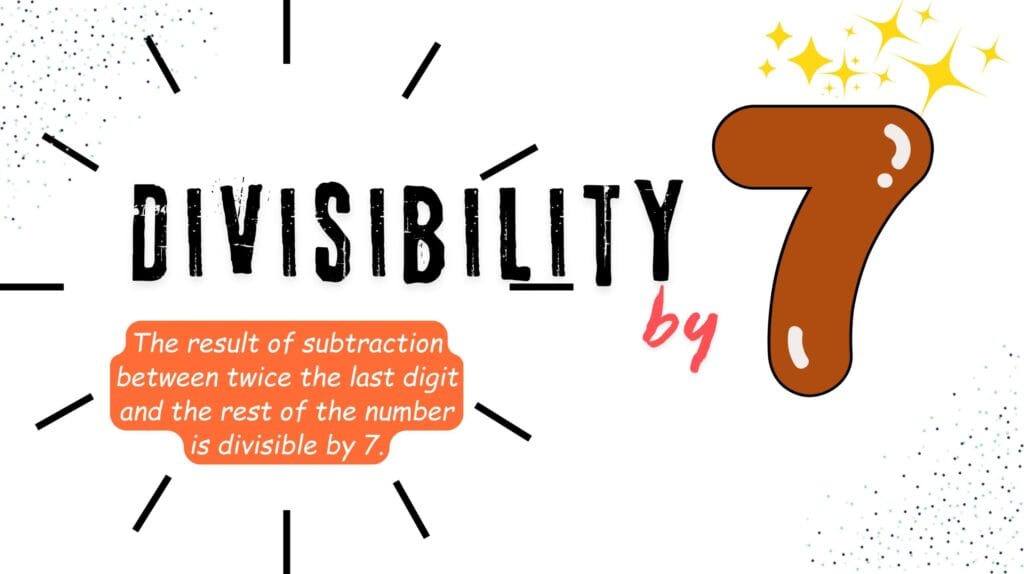What are divisibility rules? These are shortcut techniques to find factor or multiples of a number.
Table of Contents
Introduction
When it comes to mathematics, understanding the rules for division can make our calculations faster and easier. These rules help to determine whether a number can be divided evenly by another number without actually performing the division process.
Here, we shall learn the these rules for numbers from 2 to 31, providing examples of numbers that satisfy these rules and those that do not. However, to keep the content short only 7 the most used are discussed here, the rest are in the attachment.
Note:
- All numbers, excluding prime numbers, can be solved using these rules of division.
- Prime numbers demand special attention when it comes to divisibility.
- Few rules are mentioned here for the sake of comprehension.
- Composite numbers are divisible by combination of lesser composite and prime numbers.
What is a Divisibility Rule?
It is a shortcut that helps us quickly determine if a given number is divisible by another number. For instance, if you want to know if 18 is divisible by 3, you can use the rule rather than dividing 18 by 3. These rules simplify math problems and are especially useful in higher-level mathematics, such as algebra and number theory.
8 Most Basic Divisibility Rules
Divisibility by 2
A number is said to be divisible by 2 if its last digit is even (0, 2, 4, 6, or 8).
Example

Abiding Rule
![]()
The last digit is 0 which is even, so, 2520 is divisible by 2.
Defying Rule
![]()
The last digit is 1 which is not even, so, 491 is not divisible by 2.
Divisibility by 3
A number is said to be divisible by 3 if the sum of its digits is divisible by 3.
Example

Abiding Rule
![]()
Here, the sum is 9 which is divisible by 3, so, 2520 is divisible by 3[/latex].
Defying Rule
![]()
Since, 14 is not divisible by 3, so 491 is not divisible by 3.
Divisibility by 4
A number is said to be divisible by 4 if the last two digits of the number is divisible by 4.
Example

Abiding Rule
![]()
Here, 20–the last two digits–is divisible by 4 so, 2520 is divisible by 4.
Defying Rule
![]()
Since, in 491 the last two digits are 91 which is not divisible by 4, so, 491 is not divisible by 4.
Divisibility by 5
A number is said to be divisible by 5 if its last digit is either 0 or 5.
Example

Abiding Rule
![]()
As, the last digit is 0, so, 2520 is divisible by 5.
Defying Rule
![]()
Since, we have 1 as last digit, so, it is not divisible by 5.
Divisibility by 6
A number is said to be divisible by 6 if it is divisible by both 2 and 3.
Example

Abiding Rule
![]()
As the number ![]() is divisible by both 2 and 3 so it is also divisible by 6 (a multiple of both 2 and 3).
is divisible by both 2 and 3 so it is also divisible by 6 (a multiple of both 2 and 3).
Defying Rule
![]()
As the number ![]() is neither divisible by 2 nor by 3 so it is not divisible by 6.
is neither divisible by 2 nor by 3 so it is not divisible by 6.
Divisibility by 7
A number is divisible by 7 if the result of subtraction between twice the last digit and the rest of the number is divisible by 7.
![]()
If the number is still larger, repeat the process.
![]()
Example

Abiding Rule
![]()
![]()
Since, the answer 28 is divisible by 7, so, 343 is also divisible by 7.
Defying Rule
![]()
![]()
Since, 235 is still a larger number, check again for division.
![]()
Here, we have 13 which is not divisible by 7, so, 2455 is not divisible by 7.
Divisibility by 10
A number is said to be divisible by 10 if its last digit is 0.
Example

Abiding Rule
![]()
As, the last digit is 0, therefore, 2520 is divisible by 10.
Defying Rule
![]()
Here, we see 1 as last digit, so, it is not divisible by 10.
Divisibility by 11
A number is said to be divisible by 11 if the difference between the sum of the digits in odd positions and the sum of the digits in even positions are multiple of 11.
![]()
Example

Abiding Rule
![]()
![]()
![]()
As, the difference of the digits is 11 and is divisible by 11, so, 7194 is also divisible by 11.
Defying Rule
Do it yourself as an exercise and leave your answer in the comment below. For that use the your birth year and check it.
Resource Material
Here are some useful kids friendly resource material for you.
Bonus Rules
Practice Worksheet
Table Booklet
Conclusion
Understanding the divisibility rules from 2 to 31 is a valuable skill in mathematics. These rules not only simplify calculations but also enhance number sense. The more rules we are familiar with, the better we become over time with the mental mathematics as well as calculations.
Practicing these rules can help you tackle more complex mathematical concepts with ease. Whether it is a student or just someone looking to sharpen his math skills, these rules are a great tool.
Frequently Asked Questions (FAQs)
What are divisibility rules and why are they useful in mathematics?
These are fundamental rules that allow for quick determination of whether a number can be divided by another without performing full division. This simplifies calculations in basic arithmetic and is particularly helpful in algebra, number theory, and other areas of advanced mathematics.
How do divisibility rules help in higher-level math?
In higher-level math, these rules can assist in factoring, simplifying expressions, and solving equations, as well as understanding properties of numbers in topics like prime factorization, modular arithmetic, and cryptography.
Are divisibility rules the same for all numbers?
No, these rules vary depending on the divisor. Each rule is unique to the characteristics of the divisor, for example, rules for 2 and 5 focus on the last digit, while rules for 3 and 9 use the sum of digits. Some rules even require a multi-step process, as seen with divisors like 7 and 13.
Can we always apply division rules instead of doing full division?
These rules are shortcuts and work well for quick checks, but they do not replace division in all cases. For example, when accuracy or remainder information is essential, performing the actual division is still necessary.
Why do divisibility rules change for composite numbers like 6, 12, or 15?
Composite numbers have dividing rules that combine the rules of their factors. For instance, a number divisible by 6 must meet the conditions of both 2 and 3, the factors of 6. This approach leverages existing divisibility rules to test divisibility by larger composite numbers.


The article provides easy-to-understand divisibility rules. It is one of the best articles on improving number sense and mental calculation skills. Examples and explanations are very lucid and understandable for learners of all levels.
Do recommend it to others and stay tuned to explore more.